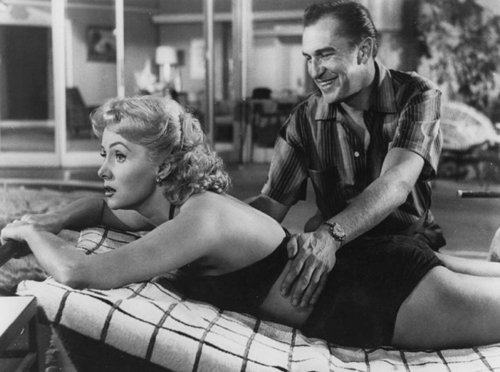By Film Noir Blonde and Mike Wilmington
The Noir File is FNB’s guide to classic film noir, neo-noir and pre-noir from the schedule of Turner Classic Movies (TCM), which broadcasts them uncut and uninterrupted. The times are Eastern Standard and (Pacific Standard).
Pick of the Week
 “Nights of Cabiria” (1957, Federico Fellini). 12 a.m. (9 p.m.); Friday, April 11.
“Nights of Cabiria” (1957, Federico Fellini). 12 a.m. (9 p.m.); Friday, April 11.
Federico Fellini takes us into the sordid, sinful, falsely glamorous, sometimes oddly appealing and sometimes dangerous night world of Roman prostitution. He and his actress wife Giulietta Masina (the magical waif of “La Strada”) create one of their most memorable characters: the childlike, hard-luck whore, Cabiria – unlucky in love, but lucky in cinema. While the buoyant but put-upon Cabiria is batted back and forth among a succession of awful johns and lovers – a thief, a philandering movie star and a gentle-eyed suitor who may be a killer – she becomes a figure of almost Chaplinesque charm and resilience. Co-written by Pier Paolo Pasolini, costarring Francois Perier, and Amedeo Nazarri, with a wonderful, typically lilting score by Nino Rota. It’s one of Fellini’s masterpieces, and the Oscar winner as 1957’s best foreign language picture.
Is it noir? Well, at least partly. In fact, imagine the same story, shot the same way, in the same stylish black-and-white, but with English-speaking actors in an American city (say, Los Angeles or New York), and you’re thinking, more than likely, of another noir. Of course, the actual American remake, Bob Fosse’s colorful “Sweet Charity,” with Shirley MacLaine, is somewhat brighter and more sentimental, but it was a musical. If anyone was a maker of noir musicals, though, it was Fosse. And, if anyone was a poet of the dark sides of the city, it was Fellini. (In Italian, with subtitles.) [Read more…]





















![Maltese-Falcon-poster[1]](http://www.filmnoirblonde.com/wp-content/uploads/2014/03/Maltese-Falcon-poster1.jpg)















From FNB readers